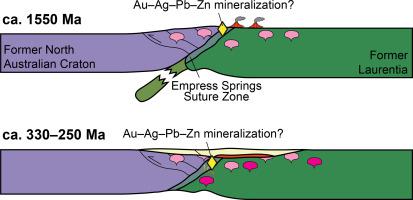Gondwana Research ( IF 6.1 ) Pub Date : 2020-12-24 , DOI: 10.1016/j.gr.2020.12.017 Hugo K.H. Olierook , Robert G. Affleck , Noreen J. Evans , Fred Jourdan , Christopher L. Kirkland , Silvia Volante , Adam R. Nordsvan , Brent I. McInnes , Bradley McDonald , Celia Mayers , R. Adam Frew , Kai Rankenburg , Nic d’Offay , Max Nind , Adrian Larking

|
Mineralization along continental suture zones is facilitated through the frequent presence of pathways from fertile mantle source regions to crustal repositories. Due to their inherent rheological weakness, these suture zones are often concealed, which hinders surface-based observations. Here, we use zircon U-Pb and sericite 40Ar/39Ar dating, and whole-rock geochemical data, to investigate the crystallization and mineralization history from a sequence of granites (sensu lato), volcanic rocks and sedimentary rocks from the Au–Ag–Pb–Zn Empress Springs Project in northeast Australia, which are under >50 m of Phanerozoic cover and located near the interpreted ca. 1.6 Ga tectonic boundary between the North Australia Craton (Mount Isa Inlier) and Laurentia (Georgetown Inlier). Zircon U-Pb dating indicates that granite emplacement, volcanic eruptions and dolerite intrusions occurred between 1564 ± 6 and 1546 ± 13 Ma (2σ), corresponding to the 1560–1550 Ma Esmeralda Supersuite and the Croydon Volcanic Group exposed in the western Georgetown Inlier. U-Pb ages from detrital zircon grains in a sedimentary rock revealed a near unimodal ca. 1560 Ma population, likely sourced from the surrounding granitic and volcanic rocks. Sericite 40Ar/39Ar dating yielded disturbed spectra with evidence for incorporation of excess radiogenic Ar, but with a probable Carboniferous to Permian age, potentially dating the timing of gold mineralization. Geochemical similarities point towards an epithermal origin for the Empress Springs Project, consistent with post-orogenic mineralization at either ca. 1560–1550 Ma or 330–250 Ma. It is likely that a series of west-dipping lithospheric-scale faults below the Empress Springs Project, here termed the Empress Suture Zone, demarcate the final suture zone associated with the assembly of Nuna. Reactivation of the Empress Suture Zone ~1.3 b.y. after crystallization with potential contemporaneous gold mineralization attests to its longevity for fluid mobility.
中文翻译:

澳大利亚东北部Nuna缝合线附近的矿化作用
通过频繁地存在从肥沃地幔源区到地壳库的途径,促进了大陆缝合带的矿化。由于其固有的流变性,这些缝合区通常被隐藏起来,这阻碍了基于表面的观察。在这里,我们使用锆石U-Pb和绢云母40 Ar / 39 Ar测年以及全岩石地球化学数据,研究了一系列花岗岩(sensu lato)的结晶和矿化历史。),来自澳大利亚东北部的Au–Ag–Pb–Zn Empress Springs项目的火山岩和沉积岩,其火山生代覆盖面> 50 m以下,且位于解释的ca附近。1.6北澳大利亚克拉通(伊萨山内里尔山)和劳伦蒂亚(乔治敦内里尔山)之间的构造边界。锆石的U-Pb测年表明,在1564±6至1546±13 Ma(2σ)之间发生了花岗岩侵位,火山喷发和白云石侵入,对应于1560–1550 Ma Esmeralda超级套房和暴露于乔治敦内西区的Croydon火山群。沉积岩中碎屑锆石中的U-Pb年龄显示出接近单峰态。1560 Ma的人口,很可能来自周围的花岗岩和火山岩。绢云母40 Ar / 39氩定年产生了干扰光谱,有证据表明掺入了过量的放射源氩,但可能有石炭纪到二叠纪,可能与金矿化时间有关。地球化学的相似性指向Empress Springs项目的超热成因,这与任一加利福尼亚州的造山后成矿作用一致。1560–1550 Ma或330–250 Ma。皇后温泉项目下方的一系列西倾岩石圈规模断层(这里称为皇后缝合区)划定了与努纳组装相关的最终缝合区。在结晶后可能同时发生金矿化作用,使Empress Suture缝合区〜1.3复活,证明了其流体迁移的寿命。


























 京公网安备 11010802027423号
京公网安备 11010802027423号